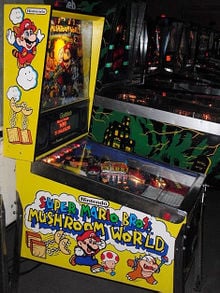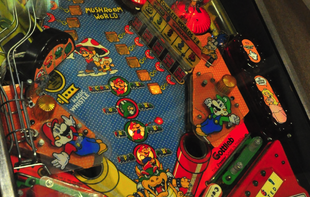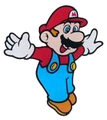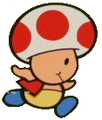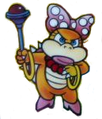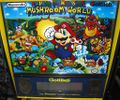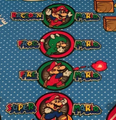Super Mario Bros. Mushroom World
- Not to be confused with Mushroom World.
| Super Mario Bros. Mushroom World | |
|---|---|
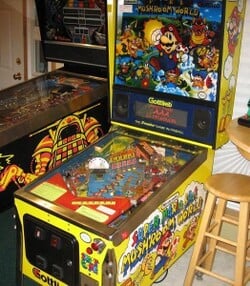
| |
| Developer | Gottlieb |
| Publishers | Gottlieb Taito (JP)[1] |
| Release date | |
| Language | English |
| Genres | Redemption Novelty Play |
| Mode | Four players[2] |
| Cabinet | Height-adjustable cabinet made of plywood |
| Monitor | Dot-matrix display |
| Input | Pinball |
- “It's Mario Mania all over again... In redemption!”
- —Marketing slogan for Super Mario Bros. Mushroom World
Super Mario Bros. Mushroom World is a coin-operated pinball machine developed by Gottlieb and licensed by Nintendo. It was released to commercial buyers in the United States in June 1992,[2] being the direct sequel to the pinball game Super Mario Bros., which was released two months earlier. Unlike its predecessor, Super Mario Bros. Mushroom World was more focused on commercial buyers, as it was given redemption features. It is also much smaller than the average pinball machine, with the table standing at only 30 inches at the lowest adjustable setting. Gameplay is based on that of Super Mario Bros. 3, as the cabinet displays the game artwork of the Koopalings and uses power-up forms, such as Frog Mario and Raccoon Mario, during gameplay. A total of 519 units was manufactured, a great deal less than its predecessor. Likewise, Super Mario Bros. Mushroom World is a much sought-after product, receiving high bids at auctions, including machines in very poor condition.[3]
Cabinet description[edit]
The pinball machine is colored yellow with several artwork themed to the Super Mario franchise, some of it original. The backbox displays a translight artwork that shows seven Koopalings in seven different worlds, with Bowser in World 8. Mario is seen in the middle holding a Super Mushroom (an artwork from Super Mario Bros.: The Lost Levels). Below the translight is a small screen that uses a dot-matrix display to show the player's current score, several video animations, and interactive games. One of such animations, taking place before the game starts, is a concerned Mario with a "Say no to drugs" message. Two speakers sit on either side of the screen, and they are used to emit music and sound effects. On top of the backbox is a red siren, which lights up on certain occasions during gameplay. Artwork is seen on the sides of the backbox, showing Raccoon Mario flying above three Clouds, leaving two mad Chain Chomps snapping below.
Moving down the pinball machine, the 1,053 square inches of playfield largely consist of artwork from the Super Mario franchise, flashing lights, and pinball gameplay elements. The side walls containing the playfield consist of more artwork; the logo of Super Mario Bros. Mushroom World is surrounded by a cloud. Mario and Toad are running from two Chain Chomps, with Morton Koopa Jr. seen on the far right. The back of the machine contains the Gottlieb logo, along with a few notices and warnings. The front of the machine has two coin slots; the left one takes quarters (25¢ American coins), and the right one takes certain-sized game tokens from arcade companies. The coins can be retrieved via the coin door, which can be unlocked with a key that comes with the machine. To the right of the coin door is a "Start Game" logo, with a red plunger that is used to pull back to send the pinball onto the playfield. Directly below the plunger and logo is the ticket dispenser, which locks to hold a reel of tickets for commercial use. The Gottlieb logo is seen to the left. The system can be set to play with or without ticket redemption.
A main focus of the product was portability. The legs have an adjustable difference of eight inches, and the cabinet is 39 inches in length. The backbox is able to be folded forward onto the playfield area. The cabinet weighs a minimum of 118 kg.[2]
Playfield layout[edit]
Unlike the average pinball machine, Super Mario Bros. Mushroom World contains no inlanes or outlanes at the bottom of the playfield. Two sinkholes that are made to look like Warp Pipes are seen above the flippers; these sinkholes return the ball below the slingshots. In between the flippers is a picture of Bowser from Super Mario Bros. 3. A plastic ramp on the left that has five pictures of Toad on the surface leads to a wire ramp. This wire ramp carries the ball back down to the left flipper. Above the Bowser picture and the two flippers are several images of Mario's suits in a vertical alignment. Each image lights up individually during gameplay. These suits, from bottom to top, are Super Mario, Fire Mario, Frog Mario, and Raccoon Mario. To the upper left of these is a picture of a Magic Whistle from Super Mario Bros. 3. Above and slightly more to the left of that is an object that is split into four sections, each with a different power-up. The power-ups, from left to right, are a Super Mushroom, Fire Flower, Frog Suit, and Super Leaf. Each power-up corresponds to Mario's suits mentioned beforehand. Directly to the right is an illustration of Mario and Toad hiding from the rain beneath a large toadstool. A speech bubble shows Mario saying, "Mama mia!"
Towards the upper area, there is a column of five Chain Chomps, each facing a drop target, all of which are made to resemble Brick Blocks. Depending on the machine version, the numbers above the drop targets vary. In one version, the order of numbers appears as five, two, three, one, and four. This indicates how many tickets the player may receive on the shot (if Redemption Mode is enabled). On the alternative version, the numbers represent how many points the player receives once the drop targets are hit. The values (each times one million) are twenty, three, five, two, and ten. Regardless of the version, both still reward points and are able to dispense tickets; only the numbers shown are different. Above the numbers is a line of text that reads "Complete Worlds 1–8" and "World 8 Darkland," with Darkland being the eighth and final world of Super Mario Bros. 3. There is an identical set of drop targets on the left side, slightly higher up on the playfield.
At the top center of the playfield, there is a smaller Magic Whistle in front of a spot target. On either side of the Magic Whistle are two sinkholes that are made to resemble Warp Pipes. The pipe on the right is colored yellow and has the words "Boom Boom" along the convex, with a picture of the titular character seen below. The sinkhole itself sends the ball to the left, where it emerges from a kickout hole. This sends it to a VUK (vertical up-kicker), which takes the ball and rolls it down an enclosed tunnel. This tunnel has a picture of Princess Toadstool on the front. Along the top is the word "Princess," with her crown pictured below. Directly below that area is the second sinkhole, which is made to resemble a red Warp Pipe. The word "Princess" is written along the convex. Entering that sinkhole initiates either the Block Buster or the Tail Attack game round. Further along the tunnel above is a series of three pictures; each of them shows Mario at a different stage of stomping Boom Boom into the ground. Each time the player enters the tunnel, a red light illuminates beneath a number that progresses to three. Beyond the tunnel is a wire ramp that carries the ball a short distance, then drops it among a group of three bumpers.
The plunger on the right side of the table is used to launch the ball onto the playfield. There is a picture of Toadstool covering the middle of the yellow track the ball follows. A speech bubble shows her saying, "Be careful Mario." Above is a picture of Mario's glove pointing to text that reads "To Mushroom World."
Gameplay[edit]
The aim of the game is to progress through eight worlds, defeating a Koopaling in each of the first seven, with Bowser found in the eighth. The player is able to complete a world by clearing the banks of drop targets found on either side of the upper playfield. There are two levels of gameplay: easy and hard. Either mode can be selected with the flippers before the player starts a game. The player can also choose whether to play the actual worlds or just play at leisure without progressing. Before plunging the ball, the game drops a number of drop targets inversely proportional to the world number. During hard mode, the player, then, has 30 seconds to hit the remaining drop targets to complete the world (the timer is disabled during easy mode). Upon plunging, the ball first gets sent to the jet bumpers at the top of the playfield. This begins the lineup game, which is seen on the screen. Each hit with the jet bumper during gameplay brings the pictures closer to lining up after the initial scrambling. Each picture is worth something. The Mushroom picture rewards the player with an extra ball. An Anchor or Music Box gives bonus points, and the rare Starman drops all of the remaining drop targets, clearing the world.
While the player plays hard mode, if they fail to drop the remaining number of drop targets within 30 seconds, the flippers become inoperable. If the player succeeds in clearing all drop targets, the timer stops and the field can be played at leisure until entering the VUK, which clears the world. When the player does not play a world, clearing the drop targets has no effect, entering the VUK starts a new lineup game, and the process repeats.
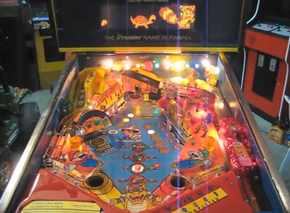
The upper right sinkhole, which displays a picture of Boom Boom, can be sunk three times to begin a two-ball multiball. The sinkhole found to the immediate left of Boom Boom is known as "Princess," and entering it initiates one of two game rounds, which is either Block Buster or Tail Attack, both of which are viewed on the dot-matrix display. These rounds reward the player with bonus points, with the number varying according to how well the player did. Block Buster involves using the flippers to make Mario jump, hitting evenly spaced blocks along a platformer level. Mario runs automatically, though it is up to the player to jump and break as many blocks as they can during the short gameplay time. The Tail Attack game involves Tanooki Mario standing stationary to the right side of the screen while several Shellcreepers approach from the left. The player must use the flippers to swing Tanooki Mario's tail and hit the Shellcreepers. The more that are hit during the limited gameplay time, the more points the player earns.
The Magic Whistle, seen on the center playfield, lights the Mushroom Ramp for a secret. When the ramp is flashing, the secrets can be collected. The first secret is Video Mode, where the player can progress through a platformer based on the Super Mario franchise by using the flippers to control Mario. There are two types of Video Mode gameplays: one where the player controls Mario to run and jump over gaps and Boos, and one where Frog Mario swims and moves up and down to avoid various enemies and obstacles such as Crabs. Other secrets accessible from the ramp are Luigi's Surprise, which completes the world the player is currently playing, and Mario's Countdown, a hurry-up mode, collected on the ramp, that rewards points. A less common secret is an extra ball as well as a large point bonus.
Clearing the first seven worlds and starting the eighth one awards the player a special, which can be a free ball, a point bonus, or other various rewards. A free game might also be rewarded, though not when the machine is set to ticket redemption. During Darkland, the eighth and final world, the drop targets are lit but drop in groups of two of their own accord. According to the game's instruction cards, the Chain Chomps "eat" them. The player must hit all the targets before they drop to gain the target value of points. After the player clears the drop targets of Darkland, their score is displayed. If it is a high score, a free game credit is earned. Only one free game can be earned per paid credit.
Staff[edit]
Licensing and supervision[edit]
Production[edit]
Design[edit]
- Ray Tanzer
Artwork[edit]
- David Moore
- Constantino Mitchell
- Jeanine Mitchell
Dots and animation[edit]
- Rand Paulin
- Daryl Moore
Software[edit]
- Bob Wilson
- Rand Paulin
Gallery[edit]
Promotional artwork[edit]
Logos and flyers[edit]
Cabinet[edit]
Playfield and gameplay[edit]
Low perspective of the center playfield with Toad's design based on the DIC Entertainment television cartoons
Panels of Morton and Wendy
Panel of Lemmy
The world lights
References[edit]
- ^ kentahashizume (August 23, 2017). スーパーマリオブラザーズ マッシュルームワールド「1ゲーム~2ボール。でゲーム終りです。」というのが なんともはや(笑) …同じ台が 神田駅前のタイトーステーションでも遊べたな。. Twitter (Japanese). Retrieved July 8, 2024.
- ^ a b c d Super Mario Bros. Mushroom World. Internet Pinball Database (English). Retrieved July 8, 2024.
- ^ Price Check Gottlieb Super Mario Bros Mushroom World | Buying and selling advice. Pinside.com (English). Retrieved July 8, 2024.
External links[edit]
- Super Mario Bros. Mushroom World information and gameplay strategy
- Glossary on pinball terms
- Super Mario Bros. Mushroom World video review from John's Arcade
